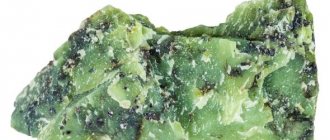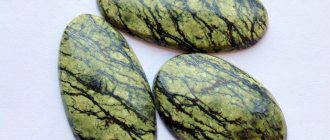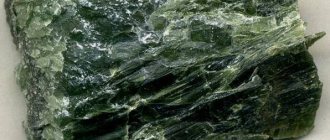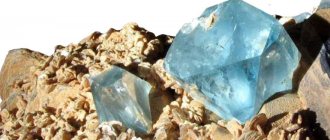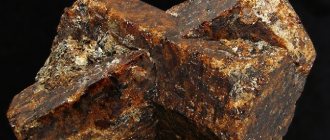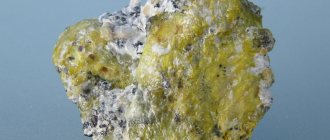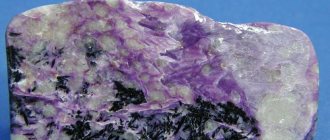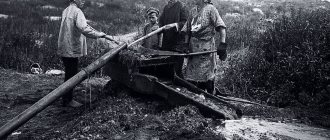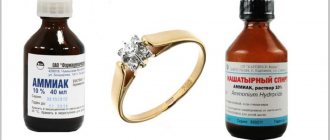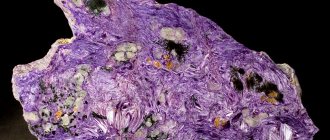Since ancient times, people have used precious minerals to make jewelry. At first, using methods of description and observation, our ancestors tried to classify gems. In the treatise “On Stones,” which Theophrastus wrote in 315 BC, one can find both a systematization of minerals and theories of their origin. Later in the Middle Ages, lapidariums appeared - collections of valuable stones. Lapidariums belong to the genre of descriptive poetry, symbolic literature. Such works not only describe precious or semi-precious stones, but attribute to them symbolic significance and certain magical properties. The first lapidary was written by the king of Arabia, Evax. He called his work “The Lapidarium of King Evax” and presented it as a gift to Emperor Tiberius.
THIS IS INTERESTING . Today, about 2.5 thousand minerals are known, however, only about a hundred of them are considered valuable. Minerals are compounds formed naturally during complex geological transformations. Thus, minerals consist of inorganic substances and have a crystalline structure. In jewelry, in addition to mineral gems, organic materials can also be used.
The scientific branch that studies precious minerals is called gemology (from the Latin word “gemma” means “precious stone”).
Gemology studies the properties of valuable minerals (optical, chemical, physical), their structure, patterns of location of deposits, technical characteristics of stone processing. In 1908, the National Association of Jewelers (NAJ), which is now better known as the Gemological Association of Great Britain, was founded. In any state where jewelry is traded, there are laboratories of gemologists. They can be both public and private. But all gemological laboratories serve one goal - to minimize the risks of buying fakes and low-quality products.
According to their origin, all precious minerals are divided into natural and artificial. Natural ones are formed during natural processes. Synthetic minerals are obtained in laboratory conditions; they are similar to natural ones in their structure and properties. Artificial minerals are inferior in price to natural ones and, as a result, are used as a material for creating various instruments.
Types of Gemstones
The classification of jewelry used by jewelers and gem dealers is extremely difficult to understand and confusing. Today, jewelers do not have a generally accepted division of precious stones. The most common classifications are according to Sobolevsky, Gurich, Kluge, and Kievlenko. Let us dwell on the 1973 classification, which was developed by E.Ya. Kievlenko. She systematized minerals, taking into account the market value of precious stones, their applicability in the production of jewelry and other craft items. Kovalenko E.Ya. divides gems into the following groups: ornamental, jewelry and precious stones, which in turn are divided into orders. The value of a mineral directly depends on the rank of its order - the higher the order, the more expensive the value of the mineral.
Gems
A mineral that is characterized by a high degree of hardness and transparency is considered precious. Such minerals can look like new for a long time and do not lose color (if any). At the head of this group are diamonds. Along with them, blue sapphires, emeralds and rubies are included
in the first order of the first group Diamonds have the highest price among other precious stones. They are obtained during diamond processing. Diamonds are the hardest natural mineral structures.
According to Mohs, they have a strength of 10 maximum points. Diamonds are several dozen times stronger than sapphires, which are rated 9 on the Mohs scale. There is an opinion that the word “diamond” comes from the Greek word “adamas” - “indestructible”; another version says that from the Persian “elma” - “hardest”. Emeralds are green beryls that are exceptionally transparent.
Their color is due to the presence of chromium or vanadium in the composition. Beryls are not very hard, but they are incredibly expensive. Dark green beryls of Colombia are considered high-grade, in the crystals of which vanadium is found. Rubies are distinguished by their rich red color. According to their chemical composition, they, like sapphires, belong to the corundum species. From Latin the word “rubeus” is translated as “red”. The most valuable are red rubies with a slight bias towards a violet hue. This color is also called “pigeon blood” color. It is quite rare to find rubies that contain rutile inclusions. Such stones will have a star-shaped optical effect (asterism effect).
Sapphires are characterized by high transparency. The presence of titanium and iron gives the mineral a blue tint. Depending on the predominance of one or another element, the shades of sapphires range from dark blue, ultramarine, cornflower blue to pale blue.
The second order of the first group includes sapphires of fancy colors, alexandrites, jadeites and black opals.
Alexandrite is chrysoberyl, which has the ability to change color depending on the nature of the lighting. So, in daylight the mineral will have a green color, and in artificial light it acquires a red-violet hue. A similar ability is given to alexandrite by particles of trivalent chromium. Opals by their chemical nature are silica hydrogels, that is, amorphous quartz that contains up to 10% water.
The most valuable is the noble black opal, which is characterized by iridescent tints on its surface. Typically, opals are not cut and are shaped into cabochons. The third order of the first group includes white and fire opals, peridot, spinel, aquamarines, topazes, moonstone and red tourmaline.
Topaz is a fluorine-containing aluminum silicate.
Topazes are a prime example of stones that got their name from the area where they were mined. Few people know that the modern island of St. Johns, located in the Red Sea, was previously called Topazos. These stones usually have pink, yellow or golden hues. There are topazes with pronounced opalescence - topaz “cat's eyes”. Topaz is a mineral with a bright shine that tolerates any treatment, including grinding. According to the Mohs scale, the density of topaz is estimated at eight points out of ten maximum. IV order of gemstones includes blue, green, pink and polychrome tourmaline, hyacinth, beryl, turquoise, amethyst, chrysoprase, garnet, citrine and noble spodumene.
Turquoise is called the “stone of heaven” - this mineral is a hydrated phosphate of copper and aluminum.
Copper ions give turquoise its sky blue color. Iron impurities can give greenish tints to the mineral. Turquoise is a gemologist's nightmare. It is almost impossible to verify its authenticity. Most often, turquoise is imitated with glass and porcelain. Jewelry and ornamental stones are characterized by low hardness, they are opaque, but have a beautiful natural color and often have a characteristic pattern.
The first order of the second group includes rauchtopaz, rock crystal, jadeite, jade, lapis lazuli, malachite and aventurine.
Malachite .
From the Greek “malakos” is translated as “soft”. The name itself indicates that malachite by nature does not require much effort in processing. Malachite can have turquoise, emerald, bluish or black-green colors. In nature, malachite is located in kidney-shaped masses, due to which a concentric pattern is visible on the saw cuts. In the old days, malachite was called “peacock stone.” The second order of jewelry and semi-precious stones includes agate, colored chalcedony, heliotrope, rose quartz, labradorite and other opaque iridescent spars.
Ornamental stones
Ornamental minerals include such minerals as jasper, granite, marble onyx, obsidian, marble and others. They are used as inserts and decoration of stone-cutting products (ashtrays, caskets, etc.).
History and origin
People have known about serpentinites for five thousand years. Jewelry and religious objects made of stone older than a thousand years are unearthed in China. The Indians of pre-Columbian America used the serpentine as a talisman. The gem was introduced to Europeans in the 16th century.
Serpentine egg
This mineral received its scientific name serpentinite or serpentine due to its resemblance to snake skin (from the Latin “serpens” - snake). The Russian-language name is serpentine. Other names for the mineral: toligor, flywheel, Korean (or new) jade.
There are enough legends about the origin of the stone, all based on the “snake” theme.
- The worldwide legend is associated with the biblical story of the Serpent - the tempter of Eve. Having given her the fruit of the knowledge of Good and Evil, he insidiously offered to share it with Adam. However, after biting into the apple, he choked. The piece that popped out turned into a green mineral.
- Residents of Southern Europe are confident that the serpentine was a fossilized poison left by reptiles during “weddings.”
- The Russian version connects the birth of the serpentine with the Great Snake. This fabulous Serpent guards the wealth of the Ural Mountains. And the green fragments of serpentinite are petrified fragments of skin, which it sheds in the spring, replacing it with a new one.
In fact, the gem is a product of metamorphism of local magnesium-rich or carbonate rocks.
Raw moss
Classification by groups
One of the difficulties in dividing precious stones into groups is their names, many of which were assigned in ancient times. It happened that the name of a mineral came from the place of its extraction or from its color characteristics. For example, golden-colored stones were called topaz, blue minerals were called sapphires. In addition, one mineral could have several fixed names. To resolve this situation, modern mineralogy introduced the concepts of species, groups and varieties of minerals.
Now the type of mineral consists of crystals of the same chemical composition. For example, aluminum oxides are corundum, beryllium and aluminum silicate are beryl. Based on the degree of transparency of the mineral and its color characteristics, one type can be divided into varieties. Species similar in chemical composition form groups of minerals.
Group of pomegranates
The garnet group is a broad type of mineral that belongs to the silicate class.
Typical representatives of the group are grant, rhodolite, grossularide, andralite, pyrope. Garnet is a dark red mineral. This gemstone has many names. In particular, Pliny the Elder called a mineral similar to flickering coals a carbuncle (from “carbon” - “coal”). Garnets, along with other red gems, were sometimes called anfrax. In Ancient Rus', pomegranates were known as chervetsy, becheta, and venice.
Rhodolite is translated from Greek as “pink stone”. Rhodolites are a type of pyrope, which is a silicate from the garnet group. Large rhodoliths are relatively expensive.
Quartz group
Quartz is silica dioxide.
This is the most common mineral. Regular glass or translucent grains of sand on the beach are great examples of quartz. Quartz is a large group of minerals. In particular, rock crystal is nothing more than its transparent variety. Amethyst is a variety of quartz that is characterized by a violet color ranging from dark purple to pinkish.
Amethysts are mined in Brazil, Uruguay and Sri Lanka. Amethysts are relatively inexpensive; this fact is primarily explained by the presence of artificial amethysts on the market, which are extremely difficult to distinguish from natural ones. Jasper is a whole class of minerals that consist of siliceous rocks with various impurities: chalcedony, iron, aluminum; constituting up to 20% of the crystal. The Greek word “iaspis” is translated as “variegated,” which indicates the color diversity of this mineral.
Group of organic materials
Organic materials are formed by a living being and, to varying degrees, consist of organic and inorganic parts. This group of materials includes coral, pearls, amber and jet.
Pearls do not require additional processing. This material is formed in the body of mollusks inside the oyster bag. A mollusk, when a particle of a foreign substance enters its body, envelops it in layers of calcium carbonate, held together by organic matter. The more layers, the larger the pearl. The growth of pearl layers is a very slow process. Natural pearls are found not only in white colors. It can be yellow, blue, red and even black.
Feldspar group
Feldspars are silicon silicates that make up up to 50% of the mass of the earth's crust.
When feldspars break down, sedimentary rocks and clay are formed. Feldspars can often be found combined with quartz crystals. Feldspars include albite, labradorite, anorthite and other minerals. Labradorite is an opaque dark blue feldspar. If you polish this mineral well, you can achieve an interesting optical effect when golden, blue, indigo and green “lights” shimmer across the surface of the mineral. In Finland, labradors are mined, which are cast in all the colors of the rainbow. They are called spectrolites.
Group of Jades
Jades are a group of translucent minerals of pyroxene and amphibole composition.
Jades include: vesuvianite, grossularite, calcite, obsidian and chrysoprase. Jadeite is the same as jade. Jadeite is a type of jade, which is distinguished by impurities of sodium compounds.
The mineral is quite durable and well valued. Hard jadeite is highly polished, so the stone can be given shine. Chromium and iron give jadeite its green color. Particularly prized is the translucent “noble” or “imperial jade,” which is mined in Burma. Obsidians are volcanic glass. In nature, you can find obsidians in black, gray, yellow, red and brown colors. Gray-white obsidians are called snow obsidians. Pendants, pendants and rosaries are often made from this stone.
Magic properties
For centuries, the snake stone was an attribute exclusively of sorcerers and magicians. Its impact is twofold.
Positive magical properties of serpentine stone:
- collects negative energy from the space and the owner;
- protects from external negativity (evil eye, damage, curse);
- stimulates the owner to improve through self-education, research or creativity;
- promotes the development of physical endurance, imagination or intuition;
- helps to withstand difficult situations, protects from problems or danger.
It was not for nothing that the properties of the stone gave it a reputation as a tempter. By leading into temptation, the serpentine tests the owner’s spiritual strength.
Bracelet made of rectangular flywheel plates
- It can easily distract the owner from his true goals, lead him astray from the right path, or lead him to vice.
- By deciding to carry out witchcraft rituals with a stone, a person risks finding himself in the center of unknown forces and getting involved in overwhelming trials.
- Serpentine is a stone of strong-willed people. He will become an assistant to the owner who has overcome fear, temptations and obstacles. But, having felt the shamanic abilities, you should not loosen control over the stone. Serpentinite, like a snake, waits to strike suddenly.
The coil helps those who treat it with respect. Does not tolerate lies or falsehood: for such owners the stone “organizes” minor troubles on all fronts.
The gem becomes attached to the first owner, whom it serves for the rest of its life. It is dangerous to give a serpentine stone as a gift or re-gift it. Only transfer to blood relatives as an inheritance is allowed.
As a talisman, the serpentine is suitable for business people, lawyers and athletes.
Types of cuts
Its brilliance and the play of light on the surface largely depend on the cut of a gemstone. Cutting refers to the technique of processing a mineral, upon completion of which a certain shape of a stone is formed with a certain number of faces, their location, proportions relative to each other and characteristic outlines. Let's look at the most commonly used types of cuts:
Round cut
Number of faces: 17, 33, 57
The round cut is something of a classic. The history of this cut goes back more than a hundred years. It is perfect for diamonds, as it collects and enhances the shine of the stone. In addition, the round cut protects the gemstone from chips and other damage. The lighter the stone (the smaller the carat), the fewer facets the jeweler will carve. Fly in the ointment - with this cut, up to 50% of the original weight of the gem is lost.
Oval cut
Number of faces: 57
This option for cutting stones has been known since the 60s of the 20th century. The “oval” cut has a more elongated shape than the round cut; and allows the stone to play with iridescence in the light. Gems cut into oval shapes are often used in rings to visually lengthen the fingers.
Marquise cut
Number of faces: 55
The Marquise cut is similar to a boat and is an oblong oval with pointed corners at the edges. As with the oval cut, the marquise cut on the ring elongates the fingers. However, be aware that the sharp wedges at the ends of the stone will become vulnerable and brittle.
Drop cut (Pear)
Number of faces: 55-56
The “Drop” combines the features of the “Marquise” and “Oval” cuts - on one side the gem will have a rounded end; and on the other hand, it’s spicy. The sharp end acts as a vulnerable point of the gemstone, prone to cracks. Therefore, experienced jewelers try to protect it with a frame. A teardrop-shaped cut of a gem in a necklace or necklace will advantageously lengthen the neck.
Princess cut
Number of edges: 49, 65,68
The “Princess” has a square or more often rectangular shape. Like the round cut, the Princess cut maximizes the brilliance and brilliance of the gem. In addition, when choosing this cut, the nugget will lose less of its original weight. This cut is often used for engagement ring diamonds. Like any other sharp corners, the tops of the “Princess” must be reliably protected by the frame.
Cabochon
Cabochoning is a method of processing stone to give it a rounded, convex shape (sometimes flat on one side). Most often, this cutting method is used when processing impenetrable or low-permeability stones; as well as stones that have any optical effects (for example, asterism or opalescence).
Medicinal properties
Healers and alchemists hold the serpentine in special esteem. It is no coincidence that the name of the mineral in their circle is apothecary stone. Even official medicine has recognized that medicines prepared or stored in “snake” containers become stronger.
A beautiful preventative or therapeutic remedy is jewelry with a coil:
- earrings - useful for hypertensive patients, neutralize migraines, headaches, vascular spasms;
- rings or bracelets - help with fractures, cuts, bruises or dislocations;
- beads or necklace - treat inflammation of colds, gastrointestinal diseases;
- rosary - calms the nerves.
The coil has the properties to protect the owner from the evil eye, damage or other mental negativity. The healing effects are enhanced by silver and cupronickel. This is the preferred setting for jewelry.
Moss fly necklace “Bride Runner”
Serpentine as a healing mineral is used by modern healers:
- kills bad energy in the room;
- gives strength during physical or emotional overload;
- removes toxins and waste;
- reduces irritability and removes excess emotions;
- strengthens the immune system;
- portends the onset of illness, starting to warm up;
- is an effective remedy for snake bites.
The stone is of particular importance as a talisman for children. The coil will develop logical thinking and strengthen the child’s memory.
Classification by quality
This list of qualities is responsible for the visual beauty and aesthetics of the stone.
Color
It is impossible to determine the type of mineral solely by color. Even minerals of the same type vary significantly in their shades depending on the presence of certain impurities. The average buyer can easily confuse, for example, topaz and sapphire. And only an experienced homologist, using special crystallographic methods, will be able to determine whether a mineral belongs to a certain species. By color there are white, yellow, purple, red, green, black, pink and blue gems.
Transparency
Transparency is a very important property of a gemstone, on which its price largely depends.
Gemologists understand transparency as the ability of a mineral to transmit light through itself. The transmission of light is influenced by the structure of the crystal; as well as the presence in the structure of the mineral of defects or inclusions that distort the flow of light. The degree of light transmission of a certain mineral is determined by a spectrophotometer. According to the degree of transparency, minerals are divided into:
- absolutely transparent - lightly colored or colorless gems, through which objects are clearly seen, without any changes;
- half transparent - colored and colorless stones, through which you can observe objects distorted or blurred;
- minerals that transmit light in thin layers. Light can usually only penetrate the surface layer, but nothing can be seen through the crystal as a whole;
- opaque - do not allow light to pass through.
Shine
Luster refers to the ability of a mineral to refract or reflect light. There are the following types of shine in precious stones:
- Diamond - the reflection of light from the surface is quite strong. Diamonds and zircon, for example, have a diamond-like luster.
- Glassy – reflects light like glass. As an example, we can name, for example, corundum.
- Waxy - slight gloss on a matte surface. Turquoise and jasper have a waxy luster.
- Metallic – strong shine on the surface of opaque minerals. For example, hematite, pyrite.
- Resinous - amber.
- Mother-of-pearl or multi-colored shimmer - pearls, opal.
Hardness
The degree of hardness of gems is determined by the Mohs scale from one to ten maximum points.
As standards, each point corresponds to a specific mineral. The undisputed leaders of the Mohs scale are diamonds - 10, followed by corundum - 9. The hardness of topaz is estimated at 8 points. Topazes are followed in descending order by quartz - 7 points, orthoclase (opal) - 6, apatite - 5, fluorite - 4, calcite - 3, gypsum - 2 and talc - 1. The arrangement of other minerals is determined by their ability to scratch each other's surface. If the material under study scratches the standard, then its hardness is higher than the hardness of the given standard; if not, lower. The harder the mineral, the denser it is, the longer it retains its cut, does not wear off and looks new.
Physicochemical characteristics
Serpentine is a magnesium silicate with impurities. They create the green color scheme and pattern of the stone. Monochrome varieties of the gem resemble jade in appearance, but softer.
| Formula | X2-3Si2O5(OH)4 |
| Color | Dark green, shades of black, brown |
| Shine | Glassy, greasy, waxy |
| Transparency | Opaque |
| Hardness | 2,5 — 4 |
| Cleavage | Absent |
| Kink | Conchoidal |
| Density | 2.2 - 2.9 g/cm³ |
The properties of the stone became part of the Ural legend. Craftsmen from Nikita Demidov's enterprises wove a tablecloth from a coil. After the feast, the owner, in front of Peter I, washed it and sent it to “dry” in the stove. The “snake” canvas remained intact.
How to wear and care
Having chosen an energetically powerful stone for jewelry, it is advisable to follow the rules of interaction with it:
- Magicians or strong people can always wear a coil. For the rest, it is enough to wear jewelry (especially body jewelry) two to three times a week.
- Even if the gem has been approved by astrologers, it is better to remove jewelry or amulets with a serpentine during apathy, depression and similar conditions.
- The gem is cleaned from ordinary dirt with soapy water and a soft cloth.
- When worn, serpentinite intensively accumulates mental negativity, and therefore needs energy purification. Flowing water can carry away a bad past. The pebble is kept under it for up to half an hour. There is no benefit to leaving a coil or decoration in standing water.
- Dry the stone on a cloth without wiping. For quick drying, wrap the product in a dry cloth (do not rub).
If you store jewelry with other stones in a “snake” box, they will also be energetically cleansed and nourished.
Sanded flywheel
Where the Great Snake left the skin
UK
Austria
Poland
USA
Germany
Switzerland
In Russia, serpentinite is found in the Urals, Sayan Mountains, and the Caucasus
Countries with serpentinite deposits:
- Great Britain;
- Austria;
- Poland;
- USA;
- Germany;
- Switzerland.
In Russia, serpentinite is found in the Urals, Sayan Mountains, and the Caucasus. Also available in Scotland.
Areas of application
In Russia, the fashion for coils came in the 18th-19th centuries. Then deposits of serpentine of luxurious colors were discovered. The stones were used in the production of small plastic items (snuff boxes, figurines, candlesticks) and in wall cladding, table tops, chess sets, and table services.
- Nowadays you can afford boxes, table lamps, candlesticks and, of course, jewelry.
- Decorating your home will only benefit from the noble beauty of the coil.
- A special conversation about bath pleasures.
Bath life
I'm talking about the bathhouse again. For Russians, “the bathhouse heals, the bathhouse rules.” For many, the bathhouse replaces psychotherapy sessions and mountains of medications.
Jadeite for a bathhouse, of course, is beyond competition. But the coil is more democratic. And it is not inferior in beauty.
Serpentine will create an aristocratic atmosphere in:
- Swimming pool (tiled).
- Sauna, bathhouse.
- Will please the fish in the aquarium.
The mineral has good thermal conductivity; it quickly absorbs heat and releases it slowly. This is “light steam”.
Expert opinion
Semenishcheva Polina
Specialist in mineralogy. Graduated from St. Petersburg Mining University.
The coil is not afraid of humidity and high temperatures.
Interesting Facts
Give a coil in January.
In addition to decorations and souvenirs, coils are used for cladding indoor walls.
Anyone who is building a house and is not short of money knows about verde antique.
This is a serpentine marble breccia that decorates kitchens and bathrooms.
In Germany, vessels for medicine have been made from coils for more than 400 years, and in other European countries the stone has been used to make interior items.
It is not recommended to give jewelry with serpentine. You need to buy them yourself or receive them as a gift (inheritance) from a blood relative.
Read the wonderful tales of Bazhov, the singer of the Stone Belt, to your children. It is not only interesting, but also educational.
Questions/Answers
A mysterious and dangerous gem leaves many questions. Ask them - we will try to answer.
How to distinguish a fake?
Honest sellers write “pressed coil”, or simply “imitation”.
What if the seller defames? Let's check the stone.
- Look through the magnifying glass at the green part of the stone. Natural fibers are visible.
- The coil is a heavy stone. If the imitation is plastic, then it is easy to detect by weight.
- Traditional thermal conductivity test. The coil will remain cool in your hand longer. Counterfeits heat up quickly.
- Look at the drawing. It is almost impossible to imitate authentically natural stone. Therefore, look at products with serpentine on the Internet, and the fakes (most likely) will not deceive you.
For your information : if in doubt, experts advise buying a Ural coil and not a stone from our Chinese friends.
How to care?
Based on hardness, it is very low. That's why:
- Store the jewelry in a separate case.
- Protect the stone from impacts, falls, and rough mechanical influences.
- Wash dirty jewelry with soapy water. Do not use a brush when washing - only a soft cloth. We washed off the dirt, rinsed with clean water, and dried with a napkin.
Who should wear it?
Honestly - better than anyone. Despite the beauty of the stone. He has a very snake-like nature.
The stone will show the unsightly underside of life. At best, this will prompt the owner of the stone to begin to remake his entire life (his own and everyone around him). In the worst case, prolonged contact can result in suicide.
How to wear?
The Roman poet Manilius exclaims:
Kohl is not strewn with stones
Don’t expect to be considered rich!
So the fashion of wearing precious stones came to us from ancient times.
We wear them in earrings. The color of the stone can perfectly replicate the color of the eyes - gray-green, green.
The soft coil in the earrings will not be scratched or deteriorated.
Interesting : earrings save you during a shipwreck and prevent you from drowning. That’s why pirates have a penchant for long and massive earrings.
What is the price?
Ornamental stone does not have to be expensive.
Today we have wonderful original works by the master from the “Fair of Masters” website. All unique jewelry is made of nickel silver using the classical filigree technique.
| Decoration | Price in rubles |
| Bracelet | 1900 |
| Ring | 400-800 |
| Pendant (pendant) | 450-600 |
| Earrings | 800-1300 |
Please note : in products with a coil, the lion's share of the price is the cost of work.
What colors are there?
Yellowish-green to dark green. May be grey.
Impurities can give serpentine a brownish-red and almost white color.
Where can I buy?
Online stores, “stone” exhibitions, jewelry stores.
When is the best time to buy?
On the 18th lunar day. The energy of the coil is at a minimum, it’s time to show the pebble who will be its owner. Just don't put it on right away. Let him lie down at home, soak in the energy of the family. Start wearing it a couple of weeks after purchase.
What stones does it go with?
Best worn with stones of the same element:
- agate;
- nephritis;
- hematite;
- onyx;
- rauchtopaz;
- morion.
